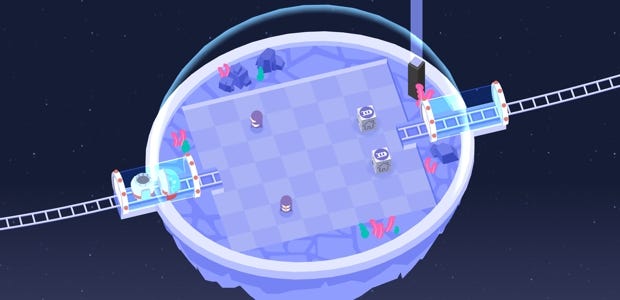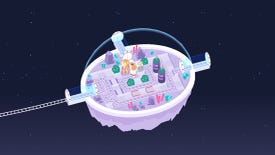Charting the puzzle depths of Cosmic Express
On the joys of multiple solutions
This is The Mechanic, where Alex Wiltshire invites developers to discuss the inner workings of their games. This time, Cosmic Express [official site].
There are many reasons why puzzle games designed by Alan “Draknek” Hazelden sit on top of the form. There’s the puzzles, for one thing. They’re pretty good. They explore seemingly simple rulesets and find in them huge and satisfying challenge, dragging you along for the ride. That’s as true for Cosmic Express as for all Hazelden’s games. (Actually, maybe that’s sort of literally true, since Cosmic Express is about drawing tracks to take aliens on little train rides.)
But there’s something else to his puzzles, something that opens up a sense of wonder at the depth of the little logical worlds that emerge from their rulesets and layouts. It’s also something that gives you a sense of involvement and discovery in a genre that can so often feel like jumping through a designer’s tortuous hoops. It’s that they have:
THE MECHANIC: Multiple solutions
There are several ways of solving Cosmic Express levels. For all of them, you have to draw a single track that will lead from the entrance to the exit, taking aliens positioned around the space to their correct box. For some of them there will be two exits and therefore two solutions, each leading to unlock a different successive level.
(Now we're going to go into spoiler territory so consider this a gentle warning.)
And for a few of the levels there are monoliths. These are Cosmic Express’ endgame, and for anyone invested in this little world they’re mind-blowing. Puzzles you thought you’d mastered, some of which you laboured over for ages, have another entirely different solution. Suddenly, this colourful, difficult, little game shows its real depths.
In each case, these multiple solutions expose the way Hazelden works, manipulating you into thinking certain ways, foreseeing your fumbling attempts to succeed and gently teaching you.
“But I don’t want them to feel like tutorials,” he says. There’s an early level in Cosmic Express called Ursa Minor 4 in which you’re given a train with two seats and the most tempting layout, where it looks like you can run the track right between sets of two aliens and then between two boxes. You know there’s got to be a catch, but you can’t help but try. “That level is one where I entice you into that by looking suspiciously easy, but it also looks like it’ll work,” says Hazelden. “Nah!” The aliens attempt to jump into the same seat, collide and neither get in.
This level teaches a couple of things. First, what happens when two aliens can potentially embark when a carriage moves through a square. This behaviour wasn’t a given during development, Hazelden settling for neither late on. “It was an ambiguity; before they’d both try to get in and one would take priority. That was unsatisfying - how can we make it unambiguous?” And second, it teaches you to start understanding the crucial business of how looping the tracks around the level can control when and where aliens embark.
Either way, that lesson had to be non-obvious. Hazelden describes what he was looking for during their design as them not being trivial. “I want them to feel like interesting puzzles in themselves. It might teach techniques but if it feels too easy then it’s not as satisfying as when it teaches something that’s satisfying to think about.”
These levels are all about misdirection, one of Hazelden’s great talents. “Particularly with Cosmic I enjoy watching people play and falling into the exact traps I’m expecting them to,” he says. “Something that I do that’s slightly passive-aggressive is, so the second level of the game [Andromeda 2] is another place where I set things up and I expect you to try and pick up both aliens and drop them both off. 90% of people do that, drawing a path by the aliens and then by the boxes, but it picks up the first and not the second and at that point I’m like…” He chuckles evilly.
It’s in this arena that the magic of multiple solutions exists. The monoliths are something that Hazelden doesn’t expect many people to notice until they’ve played the whole game. In every constellation, or group of themed levels, there is one with an unobtrusive black monolith placed somewhere in the scenery. Click on it, and it’ll animate one of the aliens and one of the boxes. To succeed at its challenge, you need to draw a route which takes that alien to its box, as well as solving the rest of the level.
“It’ll be a solution that probably won’t be the one you find automatically, taking an alien to a different box to the one you’d expect,” says Hazelden. “It’s a case of taking all the levels I’ve got and going through them with a fine-toothed comb and asking if there’s something more interesting here? Can I make you do something really awkward and does that make an even harder satisfying puzzle?”
(Alan Hazelden says “satisfying” a lot, and since it describes his levels so well, so he should.)
The idea of designing hard puzzles with hidden solutions, from the outside seems incredibly hard. “A lot of the time I can kind of get it by luck,” Hazelden says breezily. “Well, not luck, but happy accident, where there will be a good solution, and then finding other ways to solve the level is just a case of exploring the state space more fully. I really only need to design the level once and then check for alternative solutions.”
It therefore fits into his usual method of designing levels, which takes one of two general approaches. He might have a vague idea of the gameplay elements he wants the level to contain and then lay them out in an aesthetically pleasing fashion before just playing around with them. He’ll see the puzzle slowly appear, noticing when it’s impossible or too easy and then tweaking it by blocking routes or closing down areas.
Or he might have a specific idea in mind and then design a level where this idea is the only solution, tweaking to disguise it when the solution is too obvious and removing parts which aren’t relevant to it. All this is happening in Stephen Lavelle’s puzzle game engine Puzzlescript, which Hazelden uses to prototype mechanics and build every level before finally exporting them into Unity.
By the way, for more on this, Marsh talked to Hazelden a while back, along with some other puzzle designers, about how they design their levels. It’s a super read.
It’s rather beautiful that the design of these incredibly demanding puzzles should come from exploration, tentative forays into layouts that mirror your own as you attempt to solve them.
“It’s satisfying as a design to force your players to explore the state space as much as you have,” he says, proud of how they invite mastery without the arbitrary legwork that other puzzle games put their players through, like grasping for the three-star solution. “Or even worse, a move counter telling you that you could’ve done this level in 12 moves. I hate that. I hate that so much, because nobody has gone through and checked that it is an interesting challenge. Because if I did it in 15, a lot of the time the difference between the two solutions is not a lot, just a lot of gruntwork. They won’t be interestingly distinct, whereas when I’m hand-authoring secret solutions to be interestingly distinct from the solution I expect you to find first.”
There’s closeness between designer and player in these moments. Instead of Hazelden watching you, delighted when you fall into his traps, there’s a sense that when you’re attempting to discover these alternative solutions, you’re finally working together.
















